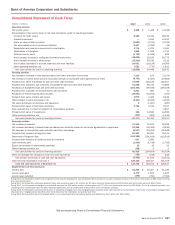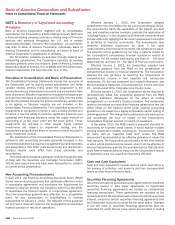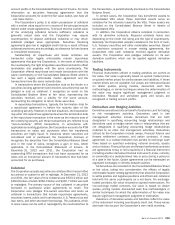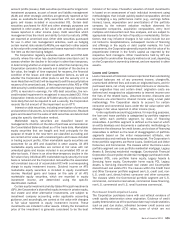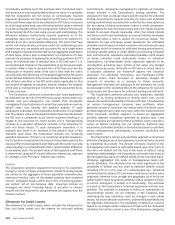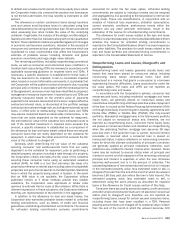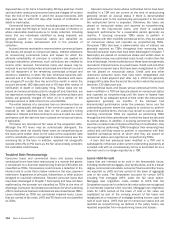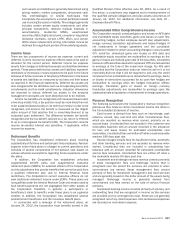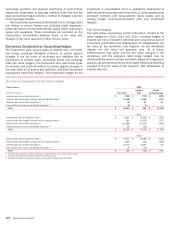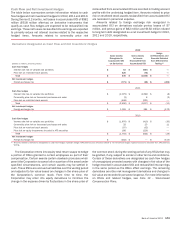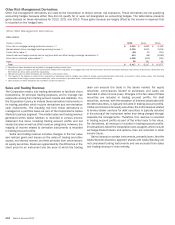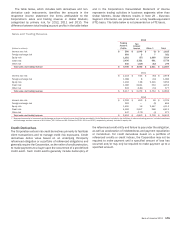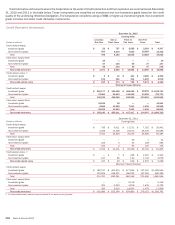Bank of America 2012 Annual Report Download - page 168
Download and view the complete annual report
Please find page 168 of the 2012 Bank of America annual report below. You can navigate through the pages in the report by either clicking on the pages listed below, or by using the keyword search tool below to find specific information within the annual report.166 Bank of America 2012
The Corporation primarily uses VIEs for its securitization
activities, in which the Corporation transfers whole loans or debt
securities into a trust or other vehicle such that the assets are
legally isolated from the creditors of the Corporation. Assets held
in a trust can only be used to settle obligations of the trust. The
creditors of these trusts typically have no recourse to the
Corporation except in accordance with the Corporation’s
obligations under standard representations and warranties.
When the Corporation is the servicer of whole loans held in a
securitization trust, including non-agency residential mortgages,
home equity loans, credit cards, automobile loans and student
loans, the Corporation has the power to direct the most significant
activities of the trust. The Corporation does not have the power
to direct the most significant activities of a residential mortgage
agency trust unless the Corporation holds substantially all of the
issued securities and has the unilateral right to liquidate the trust.
The power to direct the most significant activities of a commercial
mortgage securitization trust is typically held by the special
servicer or by the party holding specific subordinate securities
which embody certain controlling rights. The Corporation
consolidates a whole-loan securitization trust if it has the power
to direct the most significant activities and also holds securities
issued by the trust or has other contractual arrangements, other
than standard representations and warranties, that could
potentially be significant to the trust.
The Corporation may also transfer trading account securities
and AFS securities into municipal bond or resecuritization trusts.
The Corporation consolidates a municipal bond or resecuritization
trust if it has control over the ongoing activities of the trust such
as the remarketing of the trust’s liabilities or, if there are no ongoing
activities, sole discretion over the design of the trust, including
the identification of securities to be transferred in and the structure
of securities to be issued, and also retains securities or has
liquidity or other commitments that could potentially be significant
to the trust. The Corporation does not consolidate a municipal
bond or resecuritization trust if one or a limited number of third-
party investors share responsibility for the design of the trust or
have control over the significant activities of the trust through
liquidation or other substantive rights.
Other VIEs used by the Corporation include collateralized debt
obligations (CDOs), investment vehicles created on behalf of
customers and other investment vehicles. The Corporation does
not routinely serve as collateral manager for CDOs and, therefore,
does not typically have the power to direct the activities that most
significantly impact the economic performance of a CDO. However,
following an event of default, if the Corporation is a majority holder
of senior securities issued by a CDO and acquires the power to
manage the assets of the CDO, the Corporation consolidates the
CDO.
The Corporation consolidates a customer or other investment
vehicle if it has control over the initial design of the vehicle or
manages the assets in the vehicle and also absorbs potentially
significant gains or losses through an investment in the vehicle,
derivative contracts or other arrangements. The Corporation does
not consolidate an investment vehicle if a single investor controlled
the initial design of the vehicle or manages the assets in the
vehicles or if the Corporation does not have a variable interest
that could potentially be significant to the vehicle.
Retained interests in securitized assets are initially recorded
at fair value. In addition, the Corporation may invest in debt
securities issued by unconsolidated VIEs. Fair values of these debt
securities, which are AFS debt securities or trading account assets,
are based primarily on quoted market prices. Generally, quoted
market prices for retained residual interests are not available;
therefore, the Corporation estimates fair values based on the
present value of the associated expected future cash flows. This
may require management to estimate credit losses, prepayment
speeds, forward interest yield curves, discount rates and other
factors that impact the value of retained interests. Retained
residual interests in unconsolidated securitization trusts are
classified in trading account assets or other assets with changes
in fair value recorded in income. The Corporation may also enter
into derivatives with unconsolidated VIEs, which are carried at fair
value with changes in fair value recorded in income.
Fair Value
The Corporation measures the fair values of its financial
instruments in accordance with accounting guidance that requires
an entity to base fair value on exit price. A three-level hierarchy for
inputs is utilized in measuring fair value which maximizes the use
of observable inputs and minimizes the use of unobservable inputs
by requiring that observable inputs be used to determine the exit
price when available. Under applicable accounting guidance, the
Corporation categorizes its financial instruments, based on the
priority of inputs to the valuation technique, into this three-level
hierarchy, as described below. Trading account assets and
liabilities, derivative assets and liabilities, AFS debt and equity
securities, MSRs and certain other assets are carried at fair value
in accordance with applicable accounting guidance. The
Corporation has also elected to account for certain assets and
liabilities under the fair value option, including certain commercial
and consumer loans and loan commitments, LHFS, other short-
term borrowings, securities financing agreements, asset-backed
secured financings, long-term deposits and long-term debt. The
following describes the three-level hierarchy.
Level 1 Unadjusted quoted prices in active markets for identical
assets or liabilities. Level 1 assets and liabilities include
debt and equity securities and derivative contracts that
are traded in an active exchange market, as well as
certain U.S. Treasury securities that are highly liquid and
are actively traded in over-the-counter (OTC) markets.
Level 2 Observable inputs other than Level 1 prices, such as
quoted prices for similar assets or liabilities, quoted
prices in markets that are not active, or other inputs that
are observable or can be corroborated by observable
market data for substantially the full term of the assets
or liabilities. Level 2 assets and liabilities include debt
securities with quoted prices that are traded less
frequently than exchange-traded instruments and
derivative contracts where fair value is determined using
a pricing model with inputs that are observable in the
market or can be derived principally from or corroborated
by observable market data. This category generally
includes U.S. government and agency mortgage-backed
debt securities, corporate debt securities, derivative
contracts, residential mortgage loans and certain LHFS.
Level 3 Unobservable inputs that are supported by little or no
market activity and that are significant to the overall fair
value of the assets or liabilities. Level 3 assets and
liabilities include financial instruments for which the
determination of fair value requires significant
management judgment or estimation. The fair value for



